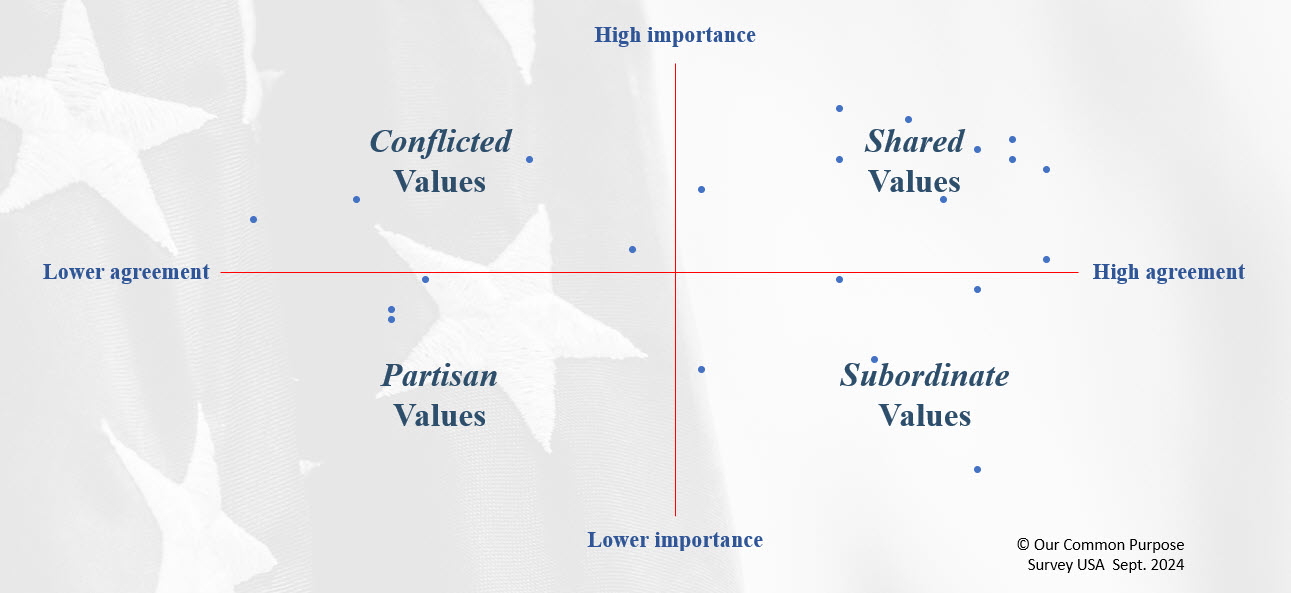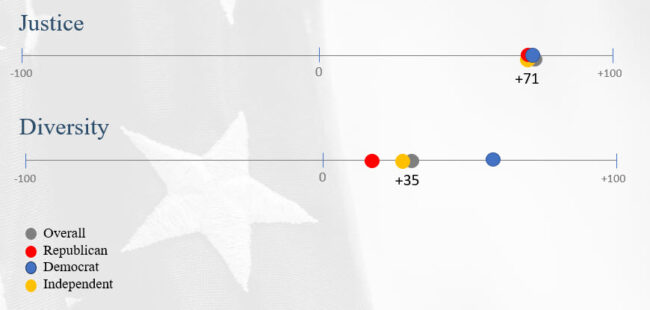Some Values Get More Regard Than Others

Part II of a series Feb. 2, 2025
Our country is built on strong, enduring values that have molded and sustained us for two and a half centuries. That’s not to say, however, that we value them all the same.
Admittedly this is a comparison that sometimes pits one strongly accepted ideal versus another. Nonetheless, we deem some values to be more important, and we’re more aligned on some than others.
These and other telling discoveries arise from Our Common Purpose’s study of American values, what about them unites and divides us, and what we might do about it.
This original work is both built upon and validates the concepts known as values pluralism, first put forward by the British scholar Isaiah Berlin way back in the 1950s, and goes on to show the unrecognized but considerable impact that values pluralism has on American society in general and political strife in particular.
The results are based in good part on a nationwide public opinion survey focusing on 25 key American values. The 2,500 participants in the study, who mirror the characteristics of the nationwide voting population, were asked in September by Survey USA to answer a lengthy set of questions using a sliding scale of -100 to +100.
The good news is that we generally hold our values in very high regard. The composite score of +59 is way up there on the scale of -100 to +100. None of the 25 tested values ended up on the negative side, meaning that even the least important is seen overall in a positive light.
But while some of the values have almost universal support, the verdict on others is mixed. For example, let’s look at the difference between the values of justice and diversity.
Justice is one of our foremost ideals, with a composite importance of +71 on the scale of -100 to +100. Just as noteworthy, Republicans, Democrat and independents accorded it virtually equal respect, the three groups averaging +70, +72, and +70, respectively.
Outside of this political alignment, the constancy is not entirely perfect. Justice gets slightly lower marks from Native Americans, Asians and from younger people, in particular for some reason 18-to-34-year-olds who live in the suburbs. But the great majority of demographic groups view justice within close proximity of the figures quoted above.
 Diversity, which in recent years has evolved into the DEI (diversity, equity and inclusion) initiatives that have been subjected to heavy attack by Republicans, is a far different story.
Diversity, which in recent years has evolved into the DEI (diversity, equity and inclusion) initiatives that have been subjected to heavy attack by Republicans, is a far different story.
It scores +35, a comparatively low figure, largely but not entirely because of a gaping disparity among political persuasions. Democrats put it at +59, independents +28, and Republicans shove it way down to +15. The gap between “very liberals” (+74) and “very conservatives” (+8) is revealing.
This survey was taken during the time Donald Trump was disparaging DEI on the campaign trail but before his administration began dismantling DEI structure and instructions within the federal government.
Aside from the political differences, the only demographic difference of any note is race. Blacks give diversity more importance. Whites, particularly white males, give it less.
When it comes to overall comparisons, the more meaningful insight is this. For virtually every demographic (including race), the lowest scores for justice meet or exceed the highest scores for diversity. Across the board, diversity just isn’t seen as important. Even blacks score it lower than they do justice.
The intent here is not to take a stand — one way or the other — on the news of the day. Rather it’s to point out that diversity is an example of lower-rated values – as we will see, there are others – that are more susceptible to criticism and politicization.
Diversity and justice are just that, examples. In like manner, the comparative acceptance of the 25 values that are part of this study can be segmented as follows:
- Values, such as justice, that are accorded high levels of importance, and enjoy high levels of agreement across political persuasions. We might call these our Shared Values*.
- Values that are given somewhat lesser importance, and yet still enjoy high levels of agreement across political persuasions. We might call these our Subordinate Values.
- Values that are accorded high levels of importance, but that are beset with less agreement across political persuasions. We might call these our Conflicted Values.
- And finally values, diversity being one, that endure the double whammy of lesser importance and less agreement. For reasons we shall see, we might call these our Partisan Values*.
Please note that the names of the two segments marked with an asterisk* were changed on February 15, 2025. They were originally named Paramount Values and Politicized Values.
The four segments can be plotted on a 2×2 matrix such as the one presented on the home page. In the next installment of this series, we’ll populate the chart with all 25 values.
Part I: Our Key Values Both Unite and Divide
Part II: Some Values Get More Regard than Others
Part III: How 25 American Values Stack Up
